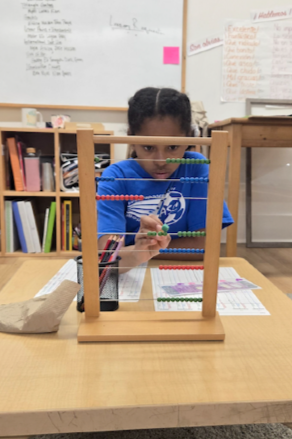Dr. Maria Montessori recognized several characteristics in elementary-aged children, one being responsibility, or the need have to be active contributors to their community; whether that community is their family, a group of children they are working with at school, all of the people in their classroom, another group like Scouts or a sports team, or even humanity as a whole.
Lower Elementary Chore Chart
Montessori parents know the importance of a carefully prepared environment for their children’s learning and development. But while preparing that environment is mostly the work of the adults, learning how to care for it is one way that Elementary children practice responsibility to themselves and others.
Cleaning shelves is part of care of the environment
In Montessori Elementary Classrooms, children have a lot of opportunities to practice responsibility. In Lower Elementary Classrooms (ages 6-9), every child has a weekly Care of the Environment task that helps their classroom run smoothly. In addition, when they work collaboratively, children take responsibility for contributing to the project they’ve chosen, and cooperating with other group members to finish their work on time and share it with others. Children take personal responsibility by doing their best to make choices that show respect for themselves and others.
Recently, the Upper Elementary children (ages 9-12) have been working on improving their largest piece of work: their learning journals! Each day, elementary students are expected to make a record of their classroom activities. For the very youngest elementary children, this may look like a clock stamp with the time recorded and the name of the lesson or a picture of the work drawn in their journal. As children get older, the learning journal becomes a tool for reflection as well as recording; the oldest elementary children write paragraphs reflecting upon their chosen work throughout the day, and many of them make the pages beautiful with fancy lettering or other embellishments. They might also use the day’s page to write down ideas they have for future work, research, questions they want to remember to look into later, or notes taken during a lesson.
The learning journal is one of the essential pieces of the elementary tools of responsibility. The guide uses the child’s record of their day to discuss work habits, work choice, stamina, and other aspects of freedom and responsibility in the classroom. For example, if a child has spent 30 minutes on a single problem, is that because the child is having trouble with the work? Trouble staying focused? Is the work too easy or too hard? Or perhaps it was a giant problem! By having a conversation together with the learning journal (and the guide’s own observations), children learn to collaborate with the guide and other children to learn how to do their best work. Truly, the learning journal is the largest piece of work that the elementary children do!
Montessori guides are trained in the skill of scientific observation; Maria Montessori’s model helps them quickly see trends in behavior and quickly adapt our approaches to meet the specific needs of their students. What’s wonderful about our school is that it is a place for children to focus on empathy and community while they’re learning academics. In Upper Elementary, the children spend time discussing—and practicing—what it means to meet an expectation even when an adult isn’t looking—what it means to build a muscle for self discipline and responsibility, and use it for things that are hard and uncomfortable.
It can take time to break down, quantify, and bring children’s awareness to the “small things” in their classroom. Over time, children start to realize their hidden skills and the expectations of their community, and work to intentionally meet them. In the long run, this is what children need: they need to be seen, they need to know their actions have an impact on their community, and they need to take responsibility and respond accordingly.




